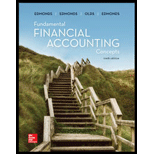
Prepare income statements, balance sheets, and statements of
Explanation of Solution
Double-declining-balance method:
It is an accelerated method of depreciation under which the depreciation declines in each successive year until the value of asset becomes zero. Under this method, the book value (original cost less
T-account:
T-account is the form of the ledger account, where the
Income statement:
Income statement is the financial statement of a company which shows all the revenues earned and expenses incurred by the company over a period of time.
Balance is the financial statement that reports a company’s resources (assets) and claims of creditors (liabilities) and stockholders (
Statement of cash flows:
Statement of cash flows is one among the financial statement of a Company statement that
Shows aggregate data of all
T-accounts are prepared as follows:
| Cash | |||
| Year 1 150,000 | 120,000 | ||
| 72,000 | |||
| Bal. | 102,000 | ||
| Year 2 83,000 | |||
| Bal. | 185,000 | ||
| Equipment | ||||
| Year 1 120,000 | ||||
| Bal. | 120,000 | |||
| Accumulated Depreciation | |||
| Year 1 | 40,000 (2) | ||
| Year 2 | Bal. | 40,000 | |
| 26,667 (2) | |||
| Bal. | 66,667 | ||
| Common Stock | |||
| Year 1 | 150,000 | ||
| Bal. | 150,000 | ||
| Year 1 Cl. 40,000 | Cl. | 72,000 | |
| Bal. | 32,000 | ||
| Year 2 Cl. 26,667 | Cl. | 83,000 | |
| Bal. | 88,333 | ||
| Sales Revenue | ||||||
| Year 1 Cl. 72,000 | 72,000 | |||||
| Year 2 | Cl. 83,000 | Bal. | 0 | |||
| 83,000 | ||||||
| Bal. | 0 | |||||
| Depreciation Expense | |||
| Year 1 40,000 (2) | Cl. | 40,000 | |
| Bal. 0 | Cl. | 26,667 | |
| Year 2 26,667 (2)26,667 | |||
| Bal. 0 | |||
Prepare income statement, balance sheets, and statements of cash flows for year 1 and year 2 using vertical format.
| Company GM | ||
| Financial Statements | ||
| Income Statements | Year 1 | Year 2 |
| Sales Revenue | $72,000 | $83,000 |
| Depreciation Expense | ($40,000) | ($26,667) |
| Net Income | $32,000 | $56,333 |
| Balance Sheets | Year 1 | Year 2 |
| Assets: | ||
| Cash | $102,000 | $185,000 |
| Equipment | $120,000 | $120,000 |
| Accumulated Depreciation | ($40,000) | ($66,667) |
| Total Assets | $182,000 | $238,333 |
| Stockholders’ Equity | ||
| Common Stock | $150,000 | $150,000 |
| Retained Earnings | $32,000 | $88,333 |
| Total Stockholders’ Equity | $182,000 | $238,333 |
| Statements of Cash Flows | Year 1 | Year 2 |
| Cash Flows From Operating Activities: | ||
| Inflow from Customers | $72,000 | $83,000 |
| Cash Flows From Investing Activities: | ||
| Outflow to Purchase Equipment | ($120,000) | $0 |
| Cash Flows From Financing Activities: | ||
| Inflow from Stock Issue | $150,000 | $0 |
| Net Change in Cash | $102,000 | $83,000 |
| Add: Beginning Cash Balance | $0 | $102,000 |
| Ending Cash Balance | $102,000 | $185,000 |
Table (1)
Working notes:
Calculate the Double-declining-balance rate:
Note: Straight line depreciation rate =
Calculate the depreciation expense (double-declining-balance method) of equipment for year 1 and year 2:
| Year |
Book value at the beginning | × | Double-declining-balance rate (1) | × | Annual depreciation expense |
| Year 1 | ($120,000-$0) | × | 0.3334 | × | $40,000 |
| Year 2 | ($120,000-$40,000) | × | 0.3334 | × | $26,667 |
Table (2) (2)
Want to see more full solutions like this?
Chapter 8 Solutions
Fundamental Financial Accounting Concepts

 AccountingAccountingISBN:9781337272094Author:WARREN, Carl S., Reeve, James M., Duchac, Jonathan E.Publisher:Cengage Learning,
AccountingAccountingISBN:9781337272094Author:WARREN, Carl S., Reeve, James M., Duchac, Jonathan E.Publisher:Cengage Learning, Accounting Information SystemsAccountingISBN:9781337619202Author:Hall, James A.Publisher:Cengage Learning,
Accounting Information SystemsAccountingISBN:9781337619202Author:Hall, James A.Publisher:Cengage Learning, Horngren's Cost Accounting: A Managerial Emphasis...AccountingISBN:9780134475585Author:Srikant M. Datar, Madhav V. RajanPublisher:PEARSON
Horngren's Cost Accounting: A Managerial Emphasis...AccountingISBN:9780134475585Author:Srikant M. Datar, Madhav V. RajanPublisher:PEARSON Intermediate AccountingAccountingISBN:9781259722660Author:J. David Spiceland, Mark W. Nelson, Wayne M ThomasPublisher:McGraw-Hill Education
Intermediate AccountingAccountingISBN:9781259722660Author:J. David Spiceland, Mark W. Nelson, Wayne M ThomasPublisher:McGraw-Hill Education Financial and Managerial AccountingAccountingISBN:9781259726705Author:John J Wild, Ken W. Shaw, Barbara Chiappetta Fundamental Accounting PrinciplesPublisher:McGraw-Hill Education
Financial and Managerial AccountingAccountingISBN:9781259726705Author:John J Wild, Ken W. Shaw, Barbara Chiappetta Fundamental Accounting PrinciplesPublisher:McGraw-Hill Education





